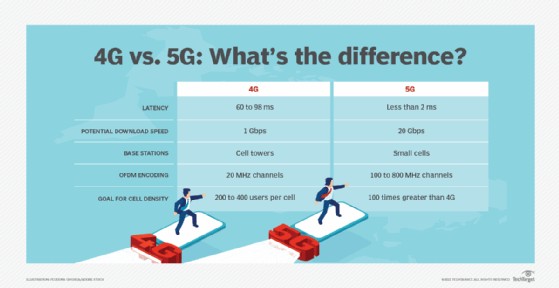5G is the latest generation of cellular network technology, promising significantly faster speeds than its predecessor, 4G. But just how much faster is 5G? This article delves into the key differences between 4G and 5G speeds, exploring latency, bandwidth, and real-world performance.
Understanding 4G Speed
4G, or fourth-generation cellular technology, revolutionized mobile internet with speeds up to 100 Mbps. This enabled high-bandwidth activities like HD streaming, video conferencing, and remote work. 4G operates using a radio system where base stations transmit signals to 4G-capable devices. The Long Term Evolution (LTE) standard further enhanced 4G’s speed and reliability, making it the dominant mobile network for over a decade.
The 5G Speed Advantage
5G surpasses 4G in speed, latency, and density. It offers peak download speeds up to 100 times faster than 4G, reaching theoretical speeds of 10-20 Gbps under ideal conditions with millimeter wave (mmWave) technology. While real-world speeds typically range from 1-3 Gbps, this still represents a substantial improvement over 4G. This dramatic increase in speed is facilitated by:
- Broader Radio Frequencies: 5G utilizes higher frequency bands, including mmWave, enabling faster data transmission.
- Advanced Technologies: 5G employs technologies like network slicing, orthogonal frequency-division multiplexing (OFDM), and massive MIMO (multiple input, multiple output) to optimize network performance.
- Small Cell Technology: Due to the shorter range of mmWave frequencies, 5G relies on a denser network of small cells, enabling faster speeds and greater capacity.
 Table that compares 4G and 5G
Table that compares 4G and 5G
Latency: A Key Differentiator
Besides speed, 5G significantly reduces latency, the delay before a transfer of data begins following an instruction for its transfer. 5G boasts latency as low as 5 milliseconds, compared to 20-40 milliseconds for 4G. This ultra-low latency is crucial for real-time applications like online gaming, augmented reality, and remote surgery.
5G Deployment and Real-World Performance
While 5G offers impressive theoretical speeds, real-world performance can vary depending on factors like location, network congestion, and device capabilities. 5G deployment is ongoing, with two main types of infrastructure:
- Standalone (SA) 5G: Utilizes a dedicated 5G core network, offering the full potential of 5G, including network slicing and ultra-low latency.
- Non-Standalone (NSA) 5G: Leverages existing 4G infrastructure, providing a faster transition to 5G but with limitations in speed and latency compared to SA 5G.
The Future of Mobile Speed
The transition from 4G to 5G is well underway, and while 4G remains widely used, 5G is poised to become the dominant mobile network. Its superior speed and latency will unlock new possibilities for various industries and applications, driving innovation and transforming how we connect with the world. 5G is more than just a speed upgrade; it represents a fundamental shift in mobile technology, enabling a future of seamless connectivity and unprecedented capabilities.
4G vs. 5G: Key Differences at a Glance
| Feature | 4G | 5G |
|---|---|---|
| Speed | Up to 100 Mbps | Up to 10-20 Gbps (theoretical), 1-3 Gbps (typical) |
| Latency | 20-40 ms | Under 5 ms |
| Frequency | Under 6 GHz | Up to 300 GHz (mmWave) |
| Infrastructure | Cell towers | Cell towers and small cells |
| Technology | LTE | 5G NR, network slicing, massive MIMO |
